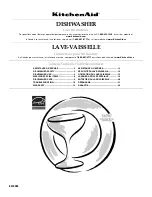
6
Starting Your Washer
1. Measure detergent and pour it into the washer. If desired, add
powdered or liquid colour safe bleach. If the water
temperature is too low, dilute the detergent in warm water.
Add extra detergent for the Super Wash cycle. Follow
detergent manufacturer’s directions.
■
Drop a sorted load of clothes loosely into your washer.
■
Load evenly to maintain washer balance. Mix large and small
items. Larger items such as sheets should be added last.
■
Items should move easily through the wash water.
Overloading can cause poor cleaning.
■
To reduce wrinkling of permanent press clothes and some
synthetic knits, use a large load size to provide more space
(see step 5).
2. (OPTIONAL) Pour measured liquid bleach into the liquid
bleach dispenser. Bleach will be dispensed automatically
during the wash part of the cycle.
■
Never use more than 250 mL (1 cup) for a full load. Use
less with a smaller load size.
■
Follow the manufacturer’s directions for safe use.
■
To avoid spilling, use a cup with a pouring spout. Do not
let bleach splash, drip, or run down into the washer
basket.
■
Use only liquid bleach in this dispenser.
3. Close the washer lid.
4. Turn the LOAD SIZE selector to the correct setting for your
wash load and the type of fabric being washed.
■
Choose a load size that allows the load to move freely for
best fabric care. See "Loading."
■
You may change the load size selection after the washer
has started filling by turning the selector to a different
setting.
5. Set the TEMPERATURE selector to the correct setting for the
type of fabric and soils being washed. Use the warmest water
safe for fabric. Follow garment label instructions.
Your washer uses
automatic temperature control to maintain
a uniform water temperature by regulating incoming hot and
cold water. This helps eliminate undissolved detergent and
ensures consistent cleaning results. The cold wash is
regulated at approximately 24ºC (75ºF) by adding small
amounts of hot water during the cold fill. The warm wash is
maintained at approximately 38ºC (100ºF).
NOTE: Make sure that both hot and cold water taps are fully
turned on, or the automatic temperature control feature will
not work properly.
Fire Hazard
Never place items in the washer that are
dampened with petrol or other flammable fluids.
No washer can completely remove oil.
Do not dry anything that has ever had any type of
oil on it (including cooking oils).
Doing so can result in death, explosion, or fire.
WARNING
Electrical Shock Hazard
Plug into an earthed plug socket outlet.
Failure to follow these instructions can result in
death, fire, or electrical shock.
Do not use an extension cord.
Do not use an adaptor.
Do not remove earth pin.
Water Temp
Use For
Hot
44°C (111°F)
or above
Whites and pastels
Heavy soils
Warm
32°-43°C
(90°-110°F)
Bright colours
Moderate to light soils
Cold
21°-32°C
(70°-90°F)
Colours that bleed or fade
Light soils






























